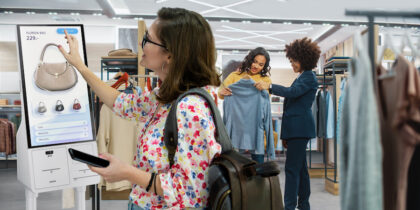The future of retail is one in which retailers will need to identify effective ways to bridge the gap between the physical and digital channels. While innovative retail companies have been doing this through cross-channel efforts like apps, in-store Wi-Fi, kiosks and geofencing, a new mobile game is driving sales and traffic at incredibly high levels. Experts say the app offers great potential to build brand loyalty, engage shoppers and lure digital consumers into the physical world.
In only a few weeks, Pokemon Go has already grown to become the largest mobile game in history with 21 million daily users, according to SurveyMonkey.com. Based on the trading card game, the Pokemon Go app lets users look for Pokemon characters in the real world. The app uses GPS and enables the camera on smartphones to scan the area for virtual characters that are overlaid onto the real-world surroundings of the user. Pokemon characters can be found just about anywhere and are bringing millions of players out to museums, public parks, malls and stores. As players search their communities for Pokemon, retailers are already using the game to increase foot traffic, spark sales and test the potential for augmented reality in retail.
Oliver Chen, an analyst at financial services firm Cowen & Co., said in a research note to investors that the app has “broad implications for retail as it addresses declining mall traffic, plus emerging trends toward social experience and health [and] wellness.”
Retailers Capitalize on the Game’s Popularity
Some businesses are already establishing themselves as “Pokemon Go-friendly zones,” and according to an article at Inc.com, many are also purchasing “Lures” to draw people closer to their storefronts. For now, retailers need little technology other than the ability to open a Pokemon account to purchase Pokemon coins.
Retailers can combine luring strategies with social media posts about nearby PokeStops and campaigns that include discounts for players. Walter Chen, founder and CEO of iDoneThis, says in another article at Inc.com that luring is “insanely powerful” and can virtually guarantee crowds for little more than a dollar per hour. “The ROI here is ridiculous, so if your business is anywhere near a PokeStop, this is something you absolutely have to try,” says Chen.
Pokemon Go can be a highly effective form of marketing. GameStop CEO J. Paul Raines told CNBC.com that sales have nearly doubled in the 462 stores designated as Pokemon “gyms.” Pokemon Go maker Niantic also recently announced that the game developer will soon offer “sponsored locations” where retailers can pay to be featured on the game’s virtual map.
How retailers are currently leveraging Pokemon Go may serve as a model for other augmented reality (AR) initiatives in the retail sector. Some companies are already using AR technology to enhance the shopping experience. According to an article in MIT Technology Review, furniture retailer Wayfair uses an AR app that allows users to visualize 3D models of their products in real settings. Ikea also released a virtual reality app in April that helps consumers customize virtual kitchens. Combining physical products and the physical space with digital overlay will allow retailers to access a whole new world of marketing and consumer outreach.
Pokemon Go has demonstrated the potential of augmented reality to impact a number of different industries. Learn more about the effect this phenomenon is having on businesses of all sizes here.







